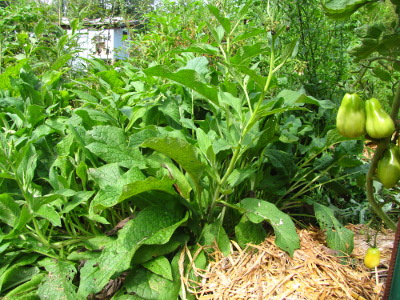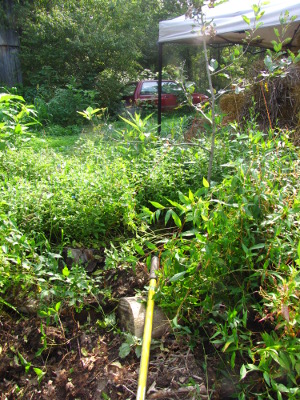
Forest garden perennials you can't kill
 If
forest garden enthusiasts are entirely honest, I think what we find
most intriguing is the idea of a semi-self-maintaining system that
gives you food with very little work once it's established. In
case I'm not the only lazy forest gardener out there, I thought I'd let
you know which plants really thrived on total
neglect (or outright
abuse) in my extremely
poor soil.
If
forest garden enthusiasts are entirely honest, I think what we find
most intriguing is the idea of a semi-self-maintaining system that
gives you food with very little work once it's established. In
case I'm not the only lazy forest gardener out there, I thought I'd let
you know which plants really thrived on total
neglect (or outright
abuse) in my extremely
poor soil.
Comfrey. I planted
comfrey directly into the ground, cut the leaves multiple times, let
Mark mow the plants to the ground, and then forgot about them for six
months until the
surrounding weeds were eight feet tall. When I came back in to
hand-weed the spot, I found the comfrey happily growing and blooming,
weed-free. The downside of comfrey, of course, is that you'll
never kill it so
that location will be home to comfrey forever.
But if you've got space far enough from fruit trees that it won't
compete
with the tree too much for nitrogen, comfrey is definitely a
neglected-forest-garden winner.
Fennel. I transplanted a
few fennel starts into another spot, again directly into the awful
soil. The fennel was run over by the truck, mowed to the ground
multiple times, and then ignored, but the plant kept popping back up
and even looked
so obviously cultivated that Mark started mowing around it. With
its deep taproot, fennel is probably tough to eradicate, but it doesn't
run like mint and does attract a lot of beneficial insects to its
flowers.
 Mint. I know I'm
starting to sound like a broken record, but I transplanted some mint
into the poor soil and let Mark mow it down multiple times and drive
over it with the truck. The mint grew so happily that
it took over the nearby hugelkultur mound that I'd made for my
apple. That's the major downside of mint --- it's easier to
eradicate than comfrey, but spreads much more thoroughly if you don't
install a root barrier. I couldn't tell how much or if the mint
was competing with the tree for nutrients, but I ripped it out of the
immediate vicinity just in case.
Mint. I know I'm
starting to sound like a broken record, but I transplanted some mint
into the poor soil and let Mark mow it down multiple times and drive
over it with the truck. The mint grew so happily that
it took over the nearby hugelkultur mound that I'd made for my
apple. That's the major downside of mint --- it's easier to
eradicate than comfrey, but spreads much more thoroughly if you don't
install a root barrier. I couldn't tell how much or if the mint
was competing with the tree for nutrients, but I ripped it out of the
immediate vicinity just in case.
I think that these three
perennials are good candidates for renovating poor soil a
good distance from fruit trees. They all produce
copious organic matter while comfrey is also a dynamic accumulator of
silica, nitrogen, magnesium,
calcium, potassium, and iron and fennel is a dynamic accumulator of
sodium, sulfur and potassium. I suspect that the trick to using
them wisely is to map out the eventual spread of your fruit tree
canopies, then plant comfrey, mint, and fennel in the spaces where the
tree leaves will never reach (adding a root barrier if you're including
mint in the mix.) Trees
will spread their roots beyond the canopy, but by the time your trees
are mature enough to reach this intercanopy area, they roots will be
better able to compete and the understory weeds will have produced
enough good soil that there won't be such a fight over nutrients.
I wish I'd though of this before scattering the three willy nilly
throughout the forest garden!
Want more in-depth information? Browse through our books.
Or explore more posts by date or by subject.
About us: Anna Hess and Mark Hamilton spent over a decade living self-sufficiently in the mountains of Virginia before moving north to start over from scratch in the foothills of Ohio. They've experimented with permaculture, no-till gardening, trailersteading, home-based microbusinesses and much more, writing about their adventures in both blogs and books.
Want to be notified when new comments are posted on this page? Click on the RSS button after you add a comment to subscribe to the comment feed, or simply check the box beside "email replies to me" while writing your comment.

I'd like to know more about how the different plants interfere with the roots of trees. In my permaculture course we were taught that plant guilds that include aromatics (like mints) are good for keeping pests away, and we saw a few examples where they were growing right up to the base of the tree. These were fig trees, though, and they are pretty tough.
When I wander around in the woodlands on my land, I notice a lot of violets and mock strawberries growing under the trees without apparent ill effects. I wonder what impact they have on the tree's feeder roots.
Not sure what the benefits would be in planting them, except that they may keep other plants form moving in (living mulch), plus the greens and flowers are nice for winter and spring salads.
A lot of permaculture advocates will tell you that there's no problem with planting comfrey right up to the trunks of fruit trees, but my experience has been very different. When I planted comfrey under my nectarine, the tree was clearly suffering lack of nitrogen as a result of competing with the comfrey.
I think what you have to understand is the concept of limiting factors. In any ecosystem, there's one factor that is available in shorter supply than others, and the plants won't grow more than that one factor will permit. The limiting factor could be light (if you're growing things in the shade), water (in a dry climate), various soil nutrients, or even topsoil itself.
In my troubled forest garden, topsoil is the limiting factor, which means that any root competition is to be avoided. I'm learning it just doesn't make sense to plant anything where the tree roots will grow if soil is the limiting factor, and that I should instead stick to mulching.
In contrast, across the pretty stark line that exists in our yard separating the good soil from the poor soil, the various components of our forest garden island around the peach show no signs of competition for soil nutrients. I have comfrey growing under the peach, but the tree shades the comfrey enough that the peach doesn't seem to suffer at all. Here, the comfrey is actually helpful since it mines nutrients from deeper in the soil where the peach roots don't grow, then releases these nutrients into the topsoil when its leaves die.
I think that most forest gardening books are set up with the assumption that light is the limiting factor (which is the case in my forest garden island.) If light is your limiting factor, the fruit trees will naturally shade out the understory enough that the tree wins any wars and thrives on the extra micronutrients produced by dynamic accumulators and also enjoys the pollinator activity spurred on by the longer bloom season in the more diverse ecosystem. (Plus you can get some edible crops from the understory.) The violets in your woods are in a similar situation --- they probably don't compete much with the tree at all, and can actually keep nutrients cycling by sucking up the nitrogen released by tree leaves in the fall.
Thanks for the excellent question that made me write far more than you wanted to read.
Not too much at all! I'm a fan of lengthy reads.
Thanks for the ecology refresher. That makes perfect sense with the violets. They do keep tiny, dark little leaves when they grow in the understory.
I've been working with succession in my garden, and trying to change the soil in stages rather than letting everything pile up on top of everything else (although it does get that way sometimes, like late summer). Right now it is still open and sunny in my little garden space.
It is certainly a quick succession. It's the only way I can afford to work right now, because I only buy one or two fruit trees per year. I've had trouble sticking trees in the ground around here. There is not a lot of topography that makes it clear why one spot might be better than another. Instead of adding soil amendments to a hole and planting the tree, it seems to help if I garden an area for a year or two and grow familiar with the soil, using good mulches and letting select weeds grow up (no formal selection process, yet), then retire the space to a perennial garden with trees and shrubs.
I haven't lost any plants this way, whereas I seem more likely to lose them if I go out and install an entire forest garden patch at once. Maybe part of the reason for that is that I am trained to tend to that area, so it becomes part of my routine long before the more expensive plants go in. It also works well with the overall pace of my gardening, which I admit is probably excruciatingly slow for folks who are used to intensive, year-round production.
I love your idea of gardening in a spot for a while before turning it over to trees! That's what people traditionally did in South America, and the idea has a lot of merit, especially for someone who doesn't know that particular patch of land (like me, you, and probably most beginning homesteaders). I certainly killed a lot of trees before I started making them grow!
The Deep South where you live is prime habitat for forest gardening. Light isn't nearly as much of a limiting factor as in areas like ours, so you can really do a multiple level canopy all in one spot if you're careful. Or so I've read...
Thanks for taking the time to write out your succession experiences --- it really helps me think better about mine.